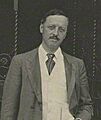Camberwell North (UK Parliament constituency) facts for kids
Quick facts for kids {{{Name}}}[[{{{Type}}} constituency]] |
|
|---|---|
| [[Image:{{{Map1}}}Constituency.svg|120px|]] [[Image:England{{{Map2}}}.svg|120px|]] |
|
| {{{Name}}} shown within [[{{{Entity}}}]], and {{{Entity}}} shown within England | |
| Created: | {{{Year}}} |
| MP: | {{{MP}}} |
| Party: | {{{Party}}} |
| Type: | House of Commons |
| County: | [[{{{County}}}]] |
| EP constituency: | [[{{{EP}}} (European Parliament constituency)|{{{EP}}}]] |
Camberwell North was a special area in South London that elected one person to represent it in the Parliament of the United Kingdom. This area was called a borough constituency. The person elected was known as a Member of Parliament (MP). They would sit in the House of Commons to help make laws for the country.
This special election area was created for the general election in 1885. It stopped being an election area after the general election in 1950.
Contents
Where was Camberwell North?
From 1918 to 1950, the Camberwell North area included specific parts of the Metropolitan Borough of Camberwell. These parts were called the Coburg, Marlborough, North Peckham, and St George's wards. A ward is like a smaller neighborhood within a larger area.
Who Represented Camberwell North?
Many different people were elected as the MP for Camberwell North over the years. They belonged to different political parties. Here is a list of the MPs who represented this area:
| Year | Member | Party | |
|---|---|---|---|
| 1885 | Richard Strong | Liberal | |
| 1886 | John Richards Kelly | Conservative | |
| 1892 | Edward Hodson Bayley | Liberal | |
| 1895 | Philip Dalbiac | Conservative | |
| 1900 | Thomas Macnamara | Liberal | |
| 1918 | Henry Newton Knights | Unionist | |
| 1922 | Charles Ammon | Labour | |
| 1931 | Arthur Bateman | Conservative | |
| 1935 | Charles Ammon | Labour | |
| 1944 | Cecil Manning | Labour | |
| 1950 | constituency abolished | ||
How Elections Worked Here
Elections were held regularly to choose the MP for Camberwell North. Sometimes, if an MP left their job early, a special election called a "by-election" would be held.
In the early years, the Liberal Party and the Conservative Party often won elections in Camberwell North. For example, Richard Strong (Liberal) won in 1885, but John Richards Kelly (Conservative) won the next year.
Around the 1900s, Thomas Macnamara from the Liberal Party was a very successful MP for this area. He won several elections in a row.
After World War I, in 1918, the election boundaries changed a bit. A new party, the Labour Party, started to become more popular. Charles Ammon from the Labour Party won a by-election in 1922 and then several general elections.
However, in 1931, during a difficult economic time, Arthur Bateman from the Conservative Party won the seat. But by 1935, Charles Ammon won it back for Labour.
The last MP for Camberwell North was Cecil Manning from the Labour Party. He won a by-election in 1944 and the final general election in 1945. The area was then split up into new constituencies in 1950.
Images for kids







